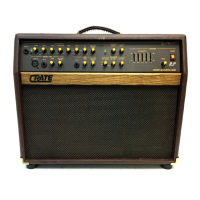28: Footswitch. Connect the supplied two-button footswitch here for remote on/off
control of the internal reverb and chorus. (When connected, the footswitch over-
rides the front panel chorus on/off switch.)
Note: This is a STEREO jack: tip controls the chorus, ring controls the reverb, sleeve
is ground. Use only a footswitch equipped with a stereo 1/4” plug.
29: Effects Loop Send. When using an external signal processor, connect this jack to the
input of the effect by means of a shielded signal cable.
30: Effects Loop Return. When using an external signal processor, connect this jack to
the output of the effect by means of a shielded signal cable.
31: High Z Bal. Use this jack to connect a high impedance, line level signal to a house
sound board, a recording console or an external power amplifier by means of an
1/4” stereo plug-terminated cable. (Ring is signal +, tip is signal -, and sleeve is
ground.)
32: Low Z Bal. Use this jack to connect a low impedance, line level signal to a house
sound board, a recording console or an external power amplifier by means of an
XLR-terminated cable. (Pin 1 is ground, pin 2 is signal +, and pin 3 is signal -.)
33: Ground Lift. This switch, when depressed, electronically disconnects the low Z bal-
anced output jack’s chassis ground connection. If you experience excessive noise
when using the low Z balanced output jack, depress this switch.
34: Line Out Level. Use this control to adjust the output level of the line out signal. (This
control works independently from the amplifier’s master level control.)
35: Tweeter Level. Use this control to adust the signal output level from the CA125D’s
internal tweeter. Rotating this control counter-clockwise reduces the tweeter’s
output level.
Not Shown:
Power cord. Connect the end of this cord to a suitable source of line voltage. Refer
to the voltage information on the back of the amplifier for its voltage and current
requirements.
Note: This is a grounded plug. To avoid the possibility of electric shock, DO NOT
defeat the ground connection in any way!
CA125D Block Diagram:
The DSP
Section:
The CA125D features Crate’s On-Board Digital Signal Processing
(DSP) technology that was designed specifically for use with acoustic
instruments and vocals. This provides a large selection of digital
reverbs, effects and delays. Select the type of effect desired by rotating
the Mode control (#22). This control is divided into five sections: Small
Area Reverbs (SAR), Large Area Reverbs (LAR), Special Reverbs (SPR),
Delays (DLY) and Multiple Effects (Multi).
The following chart provides a list of the DSP settings along with a brief
description of each effect.
SAR:
Small Room 8’ x 8’ empty room w/hardwood floor
Small Rehearsal Hall 20’ x 40’ hall, wood floors, hard walls
LAR:
Large Hall 50’ x 100’ hall, about 50 persons
Concert Hall 5000-seat hall, full crowd
SPR:
Plate Reverb Simulates studio steel plate reverb
Spring Reverb Simulates multi-spring reverb tank
DL
Y: Slapback, short 125ms delay + reverb
Slapback, Med-short 240ms delay + reverb
Slapback, Medium 350ms delay + reverb
Slapback, Long 557ms delay - 630’ travel time
Multi: Short Med. Surface 280ms delay w/21.8% regen + reverb
Medium Hard Surface 335ms delay w/26.5% regen + reverb
Chor-Delay 400ms delay with modulation
Chor-Verb Hall reverb w/modulated pre-delay
Slap-Verb Medium hall w/200ms pre-delay
Instrument Doubler Simulates second track slightly out-of-sync

